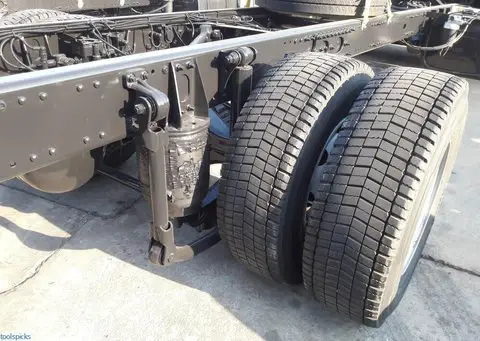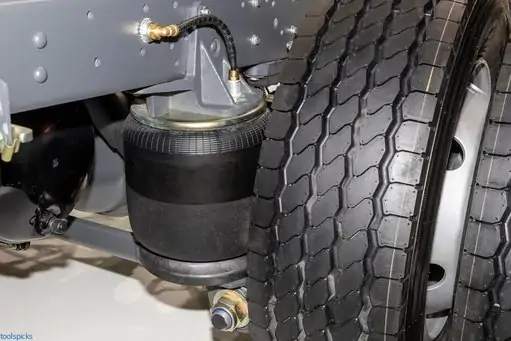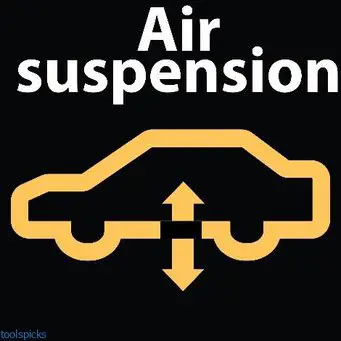How long does air suspension last? The lifespan of air suspension varies from part to part, depending on the conditions of use and maintenance. Some parts, such as the air tank and airbags, can last up to 10 years, while the air compressor and air lines may need to be replaced every 3-5 years.
This article will discuss the lifespan of the various components of an air suspension. It will also discuss the signs that your suspension is damaged. In addition, we will offer tips for extending the lifespan of your air suspension.
Average Lifespan of the Different Parts of Air Suspension
 Air Tank
Air Tank
The air tank can last a lifetime with proper installation and maintenance. The caveat is that you drain it regularly to prevent its interior from rusting. This is because compressed air condenses, especially in cold conditions.
As a result, water collects in the tank over time, resulting in rusting. It can also compromise the efficacy of the air suspension system in transmitting air through the air lines to the air shocks.
Air Suspension Compressor
The average lifespan of the air suspension compressor is 3-5 years. Most air suspension manufacturers offer a one-year warranty on the air compressor component. Therefore, it wouldn’t be unexpected if the air compressor gets damaged within 1-2 years.
Air Lines
The lifespan of air lines largely depends on whether they are installed properly and the driving conditions. They can be as short-lived as 10 minutes or last 3-5 years.
Since the air lines are partly routed externally, they can get damaged by extreme weather, being knocked by rocks, accumulation of dirt and debris constricting them, or corrosion by salt on the road during winter. Therefore, inspecting your air lines and other air suspension components with every car service is crucial to establish if they need to be replaced on time.
Airbag
Good quality airbags are durable and can last 80,000-100,000 miles or up to 10 years. Airbags are mainly made of rubber. Over time, the rubber dries out and becomes brittle from continuous use. Air bag suspensions may crack or develop tears leading to loss of air and efficacy in shock absorption.
Air Management System
The lifespan of an air suspension management system varies from one unit to another, depending on manufacturing quality. A good quality air management system can last a lifetime, but others may get damaged after a few years of use.
Valve Manifold
Typically, the valve manifold lasts 3-5 years. Its lifespan mainly depends on its build quality.
Signs Your Air Suspension Kit Has Worn Out
Knowing the signs of damage to look out for in your air suspension kit can help you repair or replace the faulty components promptly. Below are the common signs of a bad air suspension that may require suspension repair.
Bumpy Ride
The primary role of suspension systems is to ensure comfortable ride quality. Therefore, if you notice that your rides have become bumpier than usual, you need to inspect all the air suspension components for damage.
Suspension System Feels Softer Than Usual
Your rides may not necessarily be bumpier than usual. Instead, you may notice that the suspension feels softer than usual. The softness can be caused by several factors. It could be that the compressor is faulty and not providing the right air pressure.
The airbags may have a leak, or the rubber has lost its elasticity. It could also be due to damaged air lines inhibiting adequate air supply.
Vehicle Sagging on One Side
Often, this happens if the airbag on the particular wheel is worn out or has a puncture. Therefore, it is not able to support the weight of the car. In which case, you would need to replace the airbag immediately. While at it, inspect the rest of the airbags for early signs of damage and wear and tear, and replace them with new ones if need be.
Compressor Runs Continuously
The main role of the air compressor in an air suspension system is to ensure that the airbags are adequately inflated. It pumps air into the airbags in cycles. Once the air pressure is appropriate, it should stop running and resume if it drops. If the air compressor runs non-stop, it could indicate air leakage in the airbags or mechanical failure of the compressor.
Excessive Leaning When Maneuvering Corners
Another sign that your air suspension may be faulty is if it leans excessively towards the curve when maneuvering corners. You may also experience extreme body roll. It indicates that the car’s body weight is not well distributed throughout the suspension system.
Nosedive to the Front When You Brake
If you notice that the car tends to dip forward when you brake, it could indicate that the air suspension system cannot adjust its weight accordingly. Or air pressure within the system is not well regulated to offer adequate support to the vehicle’s weight.
Usually, a slight dip to the front is expected, especially when you brake abruptly. Still, if it is too pronounced or noticeable even when braking at low speeds, then it is obvious that there are some issues with the air suspension.
Tips for Extending the Lifetime of Your Air Suspension

Air suspension inspection entails checking the entire system for leaks. Since air suspension depends on the appropriate air pressure to work effectively, any slight air leakage at any point in the system will lead to pressure loss.
Therefore, a crucial part of the inspection is checking the air lines and airbags for leaks. It is also important to confirm that each air line’s connections are secure to prevent air leakage.
Check that the airbags are working properly. They should maintain a minimum pressure of 5 psi. They should also be responsive to incoming air and inflate and deflate accordingly.
Also, perform a visual inspection of the entire system. Look out for dirt and debris accumulation on all the components and clean it out. Use water and mild soap to clean the outer part. When cleaning the airbags, ensure that the suspension is at the highest height to give you good access.
Always have the air suspension inspected before embarking on a long trip. Also, if using the vehicle to haul a heavy load, have the suspension inspected before each trip.
Conclusion
The lifespan of air suspensions varies depending on factors such as manufacturing quality, whether they are installed and maintained properly, and driving conditions. Proper maintenance is crucial for extending the lifespan of your air suspension.
The most common issues with air suspensions include wear and tear of the components and air leaks. When you notice an issue, address it immediately and fix or replace the affected part to prevent further damage throughout the system.


 Air Tank
Air Tank